Case Study: Organizational Training and Work-Life Balance
VerifiedAdded on 2021/04/21
|9
|1793
|70
Case Study
AI Summary
This case study examines organizational training, focusing on work-life balance initiatives and social media policies within the context of two companies: American Express and Bain & Company. The study highlights the economic benefits of work-life balance, such as reduced turnover costs, increased job satisfaction, and improved productivity, while also discussing the advantages and disadvantages of programs that primarily support employees with children. Furthermore, the case study delves into the development and implementation of social media policies to regulate employee online behavior, including privacy settings, responsible posting, and accountability. The analysis also includes a review of Google Alerts to gauge public sentiment regarding specific political figures, offering insights into the impact of social media on public discourse.
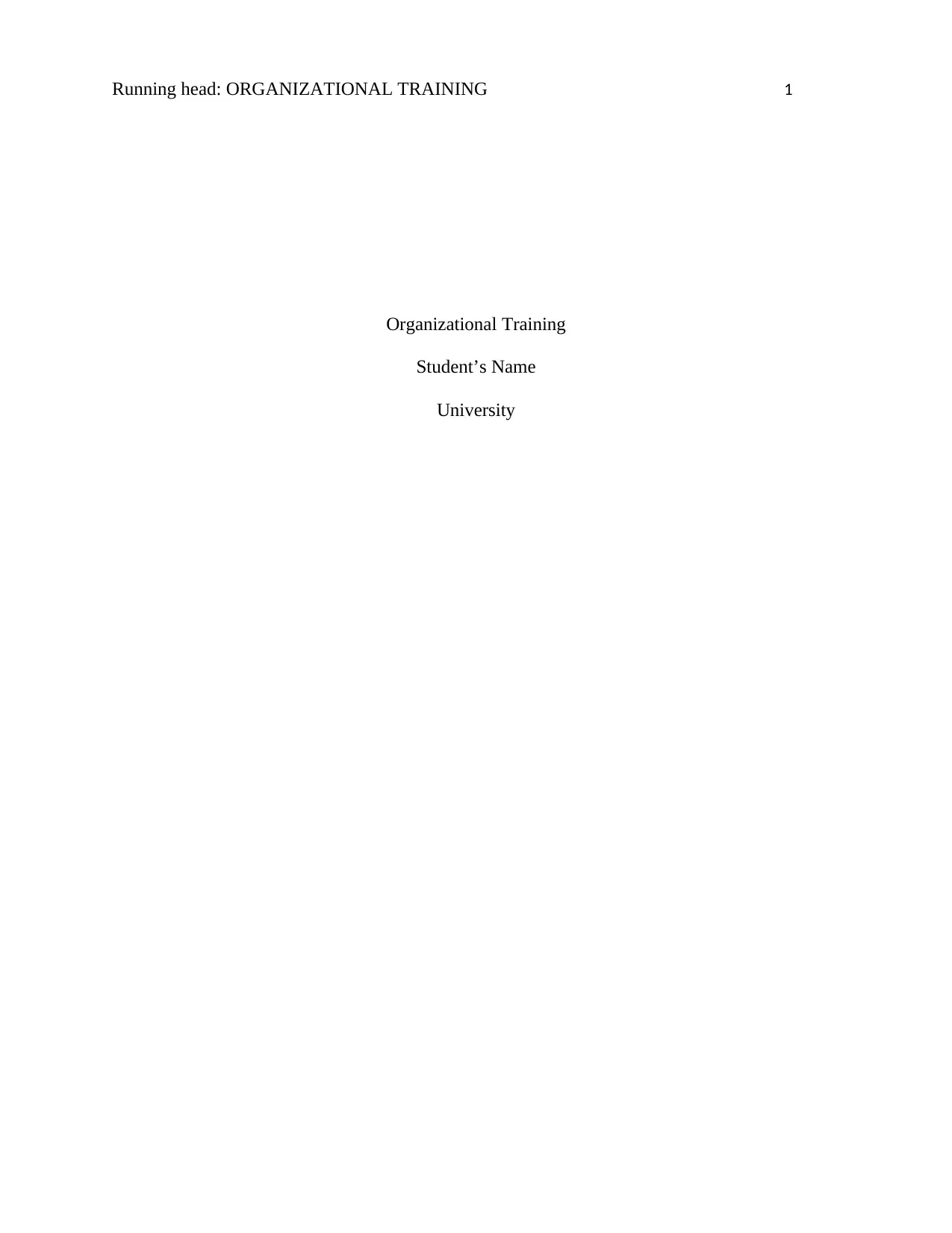
Running head: ORGANIZATIONAL TRAINING 1
Organizational Training
Student’s Name
University
Organizational Training
Student’s Name
University
Paraphrase This Document
Need a fresh take? Get an instant paraphrase of this document with our AI Paraphraser
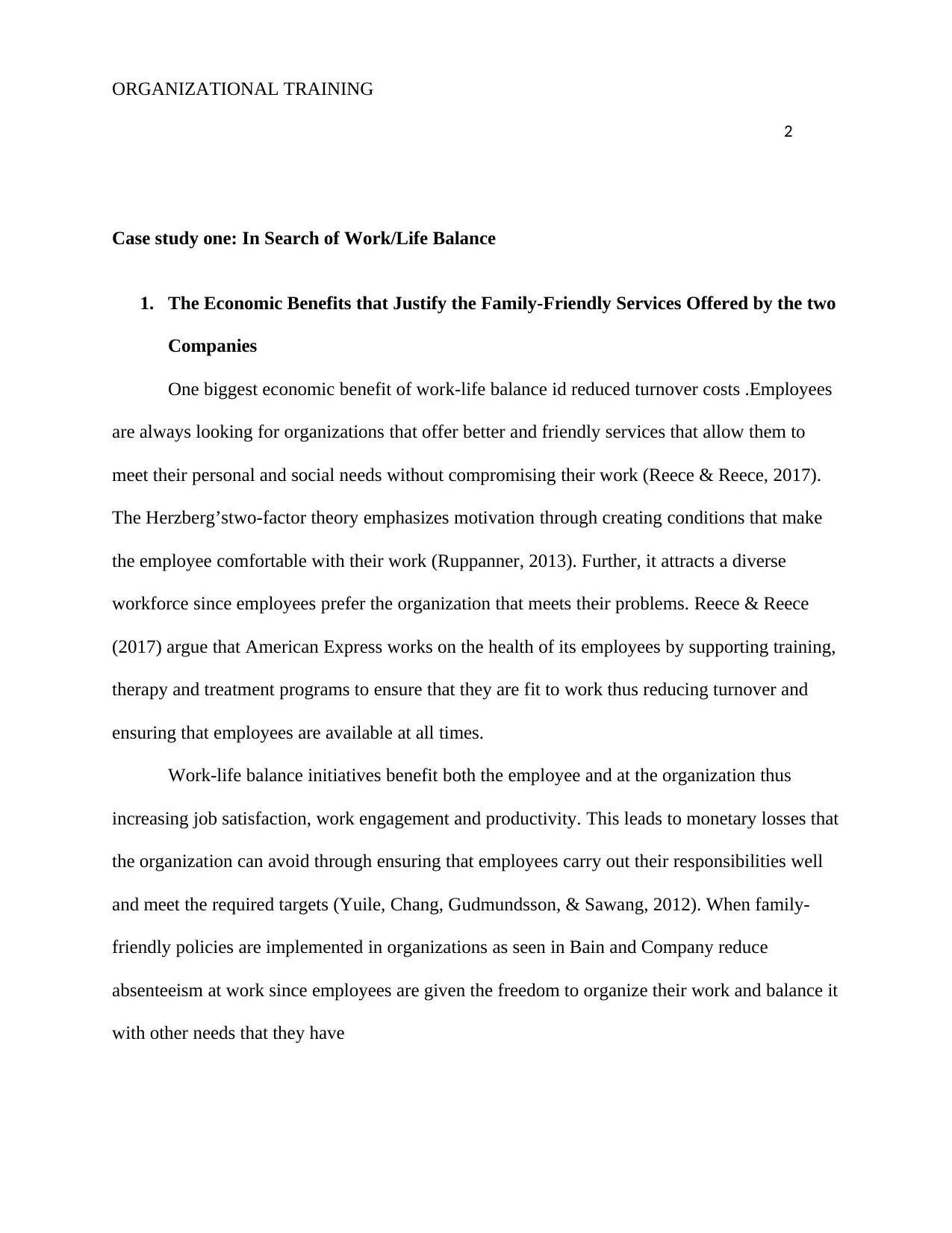
ORGANIZATIONAL TRAINING
2
Case study one: In Search of Work/Life Balance
1. The Economic Benefits that Justify the Family-Friendly Services Offered by the two
Companies
One biggest economic benefit of work-life balance id reduced turnover costs .Employees
are always looking for organizations that offer better and friendly services that allow them to
meet their personal and social needs without compromising their work (Reece & Reece, 2017).
The Herzberg’stwo-factor theory emphasizes motivation through creating conditions that make
the employee comfortable with their work (Ruppanner, 2013). Further, it attracts a diverse
workforce since employees prefer the organization that meets their problems. Reece & Reece
(2017) argue that American Express works on the health of its employees by supporting training,
therapy and treatment programs to ensure that they are fit to work thus reducing turnover and
ensuring that employees are available at all times.
Work-life balance initiatives benefit both the employee and at the organization thus
increasing job satisfaction, work engagement and productivity. This leads to monetary losses that
the organization can avoid through ensuring that employees carry out their responsibilities well
and meet the required targets (Yuile, Chang, Gudmundsson, & Sawang, 2012). When family-
friendly policies are implemented in organizations as seen in Bain and Company reduce
absenteeism at work since employees are given the freedom to organize their work and balance it
with other needs that they have
2
Case study one: In Search of Work/Life Balance
1. The Economic Benefits that Justify the Family-Friendly Services Offered by the two
Companies
One biggest economic benefit of work-life balance id reduced turnover costs .Employees
are always looking for organizations that offer better and friendly services that allow them to
meet their personal and social needs without compromising their work (Reece & Reece, 2017).
The Herzberg’stwo-factor theory emphasizes motivation through creating conditions that make
the employee comfortable with their work (Ruppanner, 2013). Further, it attracts a diverse
workforce since employees prefer the organization that meets their problems. Reece & Reece
(2017) argue that American Express works on the health of its employees by supporting training,
therapy and treatment programs to ensure that they are fit to work thus reducing turnover and
ensuring that employees are available at all times.
Work-life balance initiatives benefit both the employee and at the organization thus
increasing job satisfaction, work engagement and productivity. This leads to monetary losses that
the organization can avoid through ensuring that employees carry out their responsibilities well
and meet the required targets (Yuile, Chang, Gudmundsson, & Sawang, 2012). When family-
friendly policies are implemented in organizations as seen in Bain and Company reduce
absenteeism at work since employees are given the freedom to organize their work and balance it
with other needs that they have
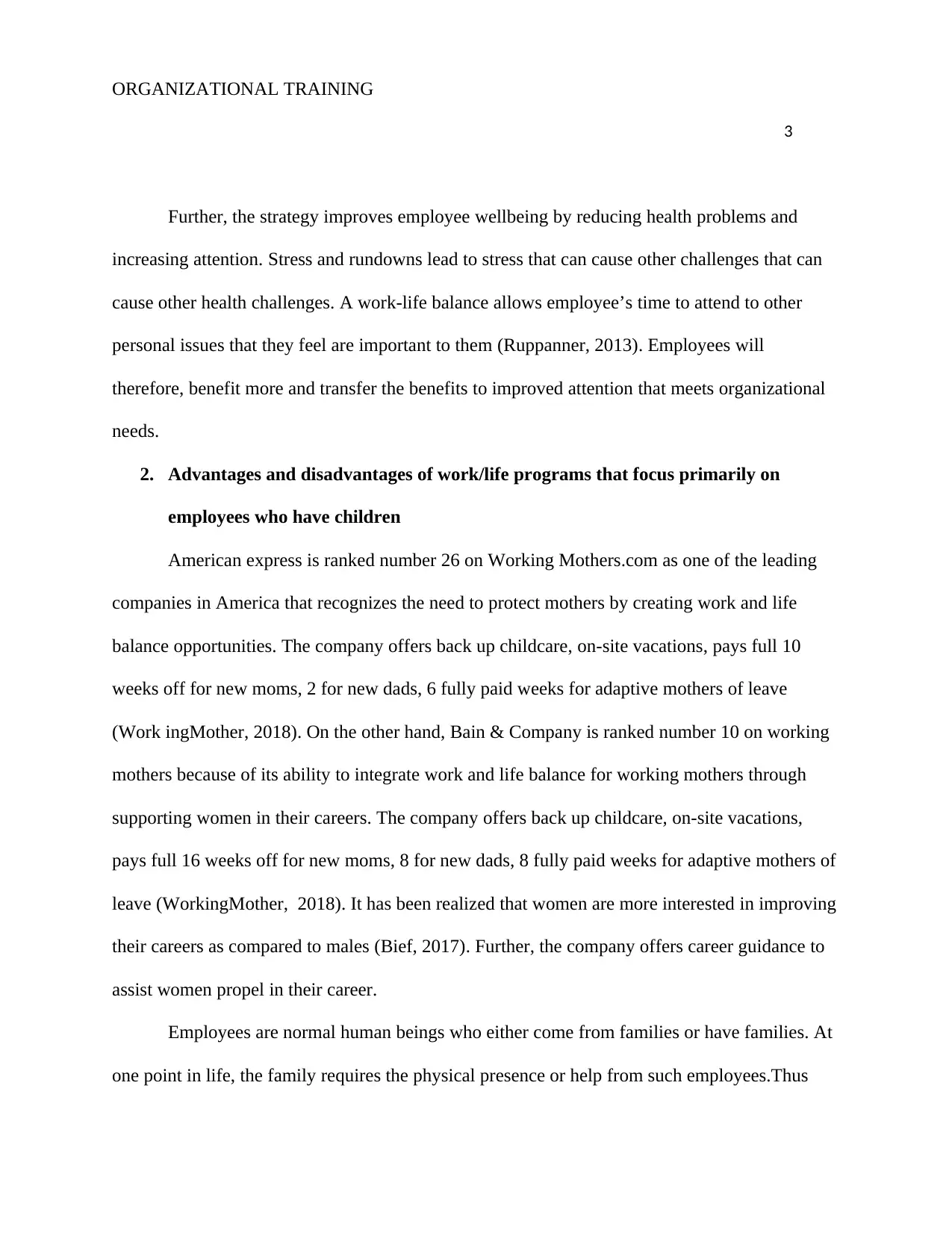
ORGANIZATIONAL TRAINING
3
Further, the strategy improves employee wellbeing by reducing health problems and
increasing attention. Stress and rundowns lead to stress that can cause other challenges that can
cause other health challenges. A work-life balance allows employee’s time to attend to other
personal issues that they feel are important to them (Ruppanner, 2013). Employees will
therefore, benefit more and transfer the benefits to improved attention that meets organizational
needs.
2. Advantages and disadvantages of work/life programs that focus primarily on
employees who have children
American express is ranked number 26 on Working Mothers.com as one of the leading
companies in America that recognizes the need to protect mothers by creating work and life
balance opportunities. The company offers back up childcare, on-site vacations, pays full 10
weeks off for new moms, 2 for new dads, 6 fully paid weeks for adaptive mothers of leave
(Work ingMother, 2018). On the other hand, Bain & Company is ranked number 10 on working
mothers because of its ability to integrate work and life balance for working mothers through
supporting women in their careers. The company offers back up childcare, on-site vacations,
pays full 16 weeks off for new moms, 8 for new dads, 8 fully paid weeks for adaptive mothers of
leave (WorkingMother, 2018). It has been realized that women are more interested in improving
their careers as compared to males (Bief, 2017). Further, the company offers career guidance to
assist women propel in their career.
Employees are normal human beings who either come from families or have families. At
one point in life, the family requires the physical presence or help from such employees.Thus
3
Further, the strategy improves employee wellbeing by reducing health problems and
increasing attention. Stress and rundowns lead to stress that can cause other challenges that can
cause other health challenges. A work-life balance allows employee’s time to attend to other
personal issues that they feel are important to them (Ruppanner, 2013). Employees will
therefore, benefit more and transfer the benefits to improved attention that meets organizational
needs.
2. Advantages and disadvantages of work/life programs that focus primarily on
employees who have children
American express is ranked number 26 on Working Mothers.com as one of the leading
companies in America that recognizes the need to protect mothers by creating work and life
balance opportunities. The company offers back up childcare, on-site vacations, pays full 10
weeks off for new moms, 2 for new dads, 6 fully paid weeks for adaptive mothers of leave
(Work ingMother, 2018). On the other hand, Bain & Company is ranked number 10 on working
mothers because of its ability to integrate work and life balance for working mothers through
supporting women in their careers. The company offers back up childcare, on-site vacations,
pays full 16 weeks off for new moms, 8 for new dads, 8 fully paid weeks for adaptive mothers of
leave (WorkingMother, 2018). It has been realized that women are more interested in improving
their careers as compared to males (Bief, 2017). Further, the company offers career guidance to
assist women propel in their career.
Employees are normal human beings who either come from families or have families. At
one point in life, the family requires the physical presence or help from such employees.Thus
⊘ This is a preview!⊘
Do you want full access?
Subscribe today to unlock all pages.

Trusted by 1+ million students worldwide
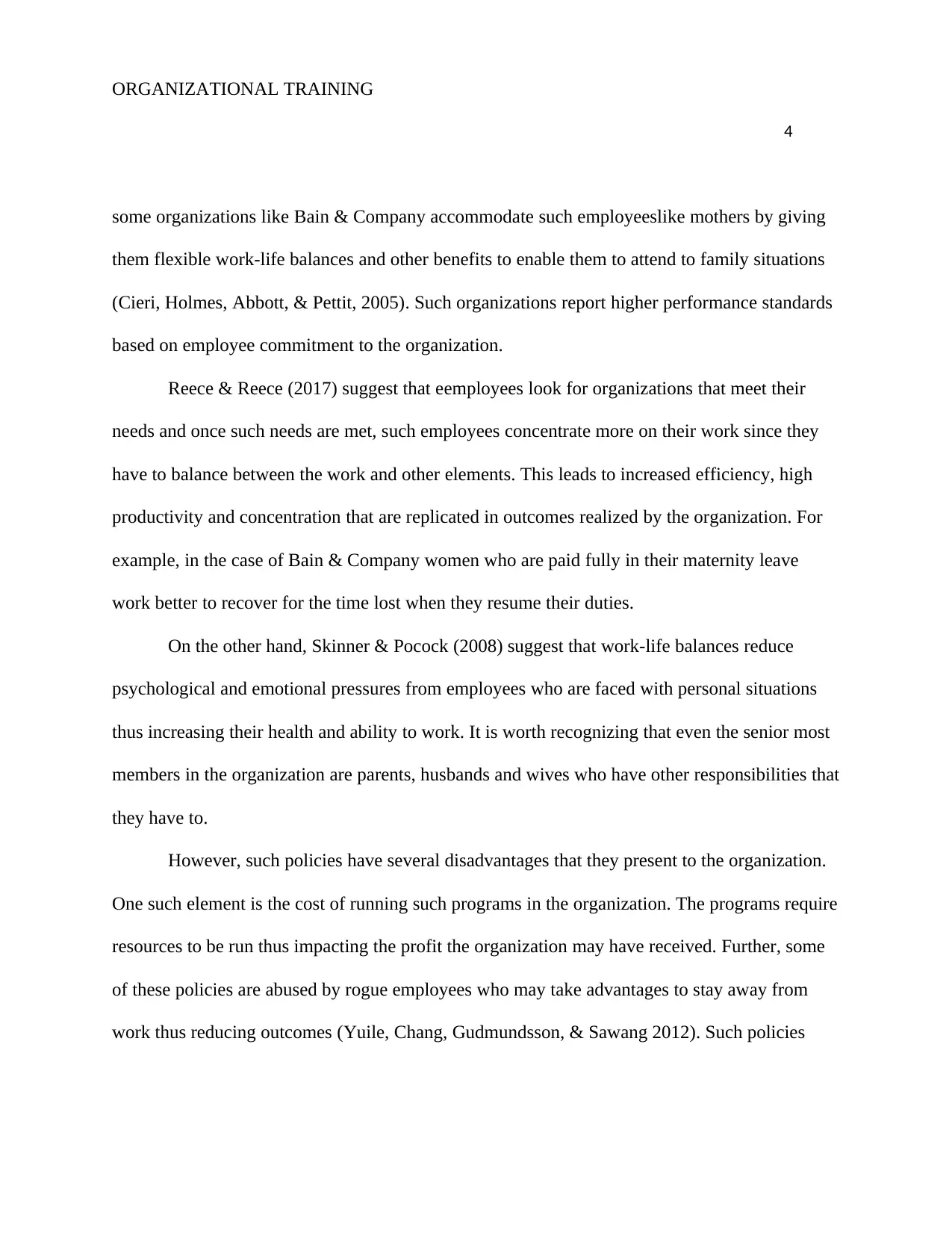
ORGANIZATIONAL TRAINING
4
some organizations like Bain & Company accommodate such employeeslike mothers by giving
them flexible work-life balances and other benefits to enable them to attend to family situations
(Cieri, Holmes, Abbott, & Pettit, 2005). Such organizations report higher performance standards
based on employee commitment to the organization.
Reece & Reece (2017) suggest that eemployees look for organizations that meet their
needs and once such needs are met, such employees concentrate more on their work since they
have to balance between the work and other elements. This leads to increased efficiency, high
productivity and concentration that are replicated in outcomes realized by the organization. For
example, in the case of Bain & Company women who are paid fully in their maternity leave
work better to recover for the time lost when they resume their duties.
On the other hand, Skinner & Pocock (2008) suggest that work-life balances reduce
psychological and emotional pressures from employees who are faced with personal situations
thus increasing their health and ability to work. It is worth recognizing that even the senior most
members in the organization are parents, husbands and wives who have other responsibilities that
they have to.
However, such policies have several disadvantages that they present to the organization.
One such element is the cost of running such programs in the organization. The programs require
resources to be run thus impacting the profit the organization may have received. Further, some
of these policies are abused by rogue employees who may take advantages to stay away from
work thus reducing outcomes (Yuile, Chang, Gudmundsson, & Sawang 2012). Such policies
4
some organizations like Bain & Company accommodate such employeeslike mothers by giving
them flexible work-life balances and other benefits to enable them to attend to family situations
(Cieri, Holmes, Abbott, & Pettit, 2005). Such organizations report higher performance standards
based on employee commitment to the organization.
Reece & Reece (2017) suggest that eemployees look for organizations that meet their
needs and once such needs are met, such employees concentrate more on their work since they
have to balance between the work and other elements. This leads to increased efficiency, high
productivity and concentration that are replicated in outcomes realized by the organization. For
example, in the case of Bain & Company women who are paid fully in their maternity leave
work better to recover for the time lost when they resume their duties.
On the other hand, Skinner & Pocock (2008) suggest that work-life balances reduce
psychological and emotional pressures from employees who are faced with personal situations
thus increasing their health and ability to work. It is worth recognizing that even the senior most
members in the organization are parents, husbands and wives who have other responsibilities that
they have to.
However, such policies have several disadvantages that they present to the organization.
One such element is the cost of running such programs in the organization. The programs require
resources to be run thus impacting the profit the organization may have received. Further, some
of these policies are abused by rogue employees who may take advantages to stay away from
work thus reducing outcomes (Yuile, Chang, Gudmundsson, & Sawang 2012). Such policies
Paraphrase This Document
Need a fresh take? Get an instant paraphrase of this document with our AI Paraphraser
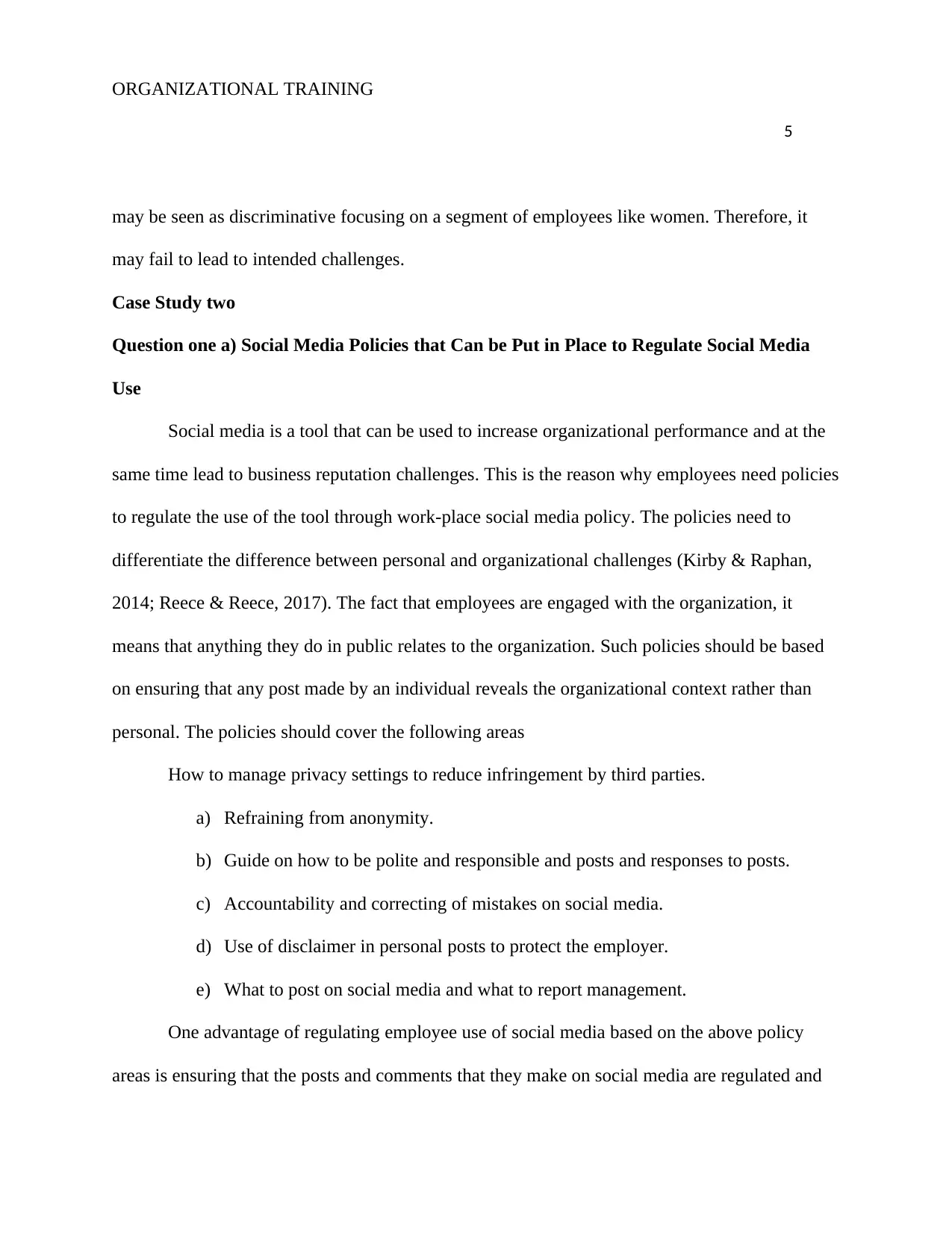
ORGANIZATIONAL TRAINING
5
may be seen as discriminative focusing on a segment of employees like women. Therefore, it
may fail to lead to intended challenges.
Case Study two
Question one a) Social Media Policies that Can be Put in Place to Regulate Social Media
Use
Social media is a tool that can be used to increase organizational performance and at the
same time lead to business reputation challenges. This is the reason why employees need policies
to regulate the use of the tool through work-place social media policy. The policies need to
differentiate the difference between personal and organizational challenges (Kirby & Raphan,
2014; Reece & Reece, 2017). The fact that employees are engaged with the organization, it
means that anything they do in public relates to the organization. Such policies should be based
on ensuring that any post made by an individual reveals the organizational context rather than
personal. The policies should cover the following areas
How to manage privacy settings to reduce infringement by third parties.
a) Refraining from anonymity.
b) Guide on how to be polite and responsible and posts and responses to posts.
c) Accountability and correcting of mistakes on social media.
d) Use of disclaimer in personal posts to protect the employer.
e) What to post on social media and what to report management.
One advantage of regulating employee use of social media based on the above policy
areas is ensuring that the posts and comments that they make on social media are regulated and
5
may be seen as discriminative focusing on a segment of employees like women. Therefore, it
may fail to lead to intended challenges.
Case Study two
Question one a) Social Media Policies that Can be Put in Place to Regulate Social Media
Use
Social media is a tool that can be used to increase organizational performance and at the
same time lead to business reputation challenges. This is the reason why employees need policies
to regulate the use of the tool through work-place social media policy. The policies need to
differentiate the difference between personal and organizational challenges (Kirby & Raphan,
2014; Reece & Reece, 2017). The fact that employees are engaged with the organization, it
means that anything they do in public relates to the organization. Such policies should be based
on ensuring that any post made by an individual reveals the organizational context rather than
personal. The policies should cover the following areas
How to manage privacy settings to reduce infringement by third parties.
a) Refraining from anonymity.
b) Guide on how to be polite and responsible and posts and responses to posts.
c) Accountability and correcting of mistakes on social media.
d) Use of disclaimer in personal posts to protect the employer.
e) What to post on social media and what to report management.
One advantage of regulating employee use of social media based on the above policy
areas is ensuring that the posts and comments that they make on social media are regulated and
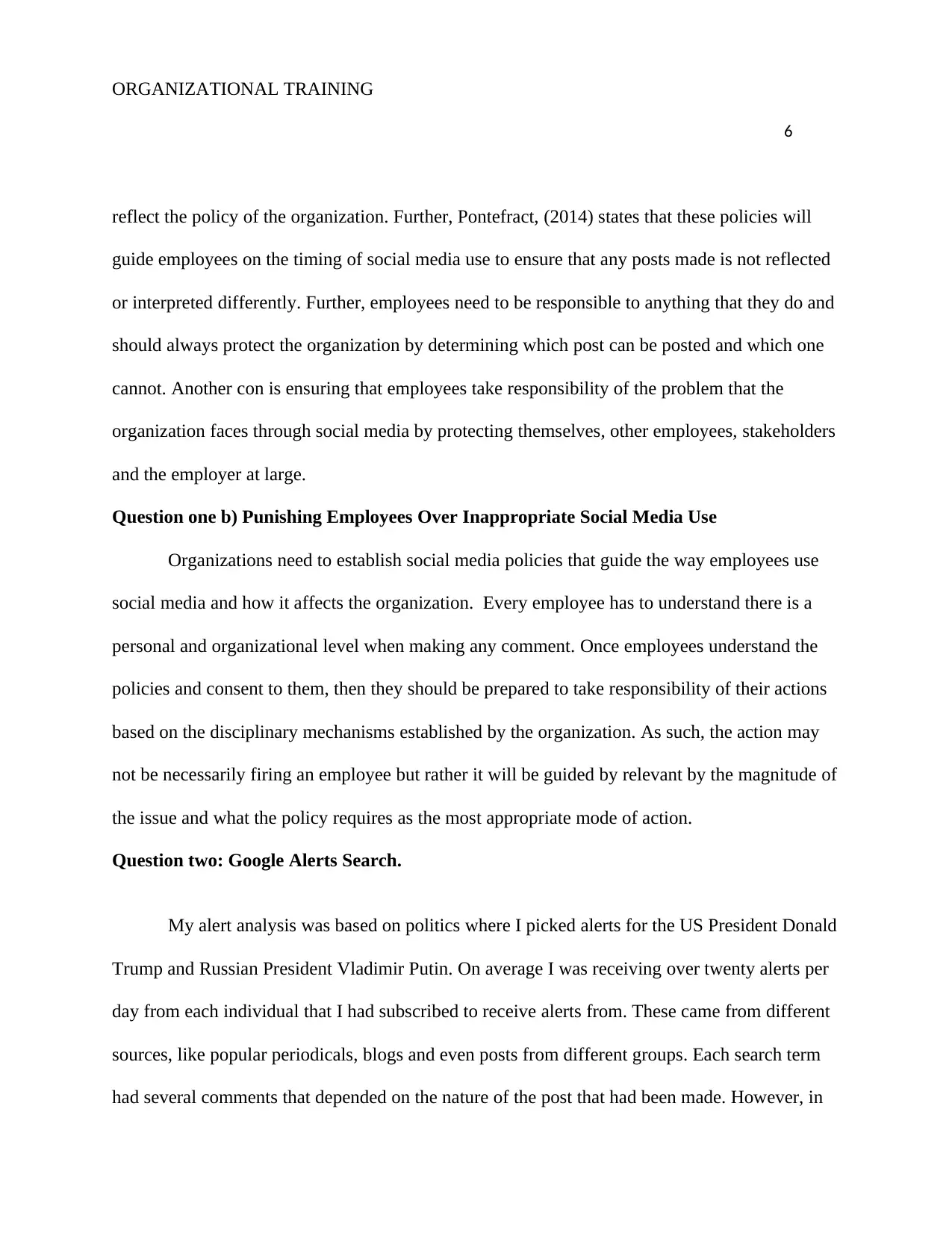
ORGANIZATIONAL TRAINING
6
reflect the policy of the organization. Further, Pontefract, (2014) states that these policies will
guide employees on the timing of social media use to ensure that any posts made is not reflected
or interpreted differently. Further, employees need to be responsible to anything that they do and
should always protect the organization by determining which post can be posted and which one
cannot. Another con is ensuring that employees take responsibility of the problem that the
organization faces through social media by protecting themselves, other employees, stakeholders
and the employer at large.
Question one b) Punishing Employees Over Inappropriate Social Media Use
Organizations need to establish social media policies that guide the way employees use
social media and how it affects the organization. Every employee has to understand there is a
personal and organizational level when making any comment. Once employees understand the
policies and consent to them, then they should be prepared to take responsibility of their actions
based on the disciplinary mechanisms established by the organization. As such, the action may
not be necessarily firing an employee but rather it will be guided by relevant by the magnitude of
the issue and what the policy requires as the most appropriate mode of action.
Question two: Google Alerts Search.
My alert analysis was based on politics where I picked alerts for the US President Donald
Trump and Russian President Vladimir Putin. On average I was receiving over twenty alerts per
day from each individual that I had subscribed to receive alerts from. These came from different
sources, like popular periodicals, blogs and even posts from different groups. Each search term
had several comments that depended on the nature of the post that had been made. However, in
6
reflect the policy of the organization. Further, Pontefract, (2014) states that these policies will
guide employees on the timing of social media use to ensure that any posts made is not reflected
or interpreted differently. Further, employees need to be responsible to anything that they do and
should always protect the organization by determining which post can be posted and which one
cannot. Another con is ensuring that employees take responsibility of the problem that the
organization faces through social media by protecting themselves, other employees, stakeholders
and the employer at large.
Question one b) Punishing Employees Over Inappropriate Social Media Use
Organizations need to establish social media policies that guide the way employees use
social media and how it affects the organization. Every employee has to understand there is a
personal and organizational level when making any comment. Once employees understand the
policies and consent to them, then they should be prepared to take responsibility of their actions
based on the disciplinary mechanisms established by the organization. As such, the action may
not be necessarily firing an employee but rather it will be guided by relevant by the magnitude of
the issue and what the policy requires as the most appropriate mode of action.
Question two: Google Alerts Search.
My alert analysis was based on politics where I picked alerts for the US President Donald
Trump and Russian President Vladimir Putin. On average I was receiving over twenty alerts per
day from each individual that I had subscribed to receive alerts from. These came from different
sources, like popular periodicals, blogs and even posts from different groups. Each search term
had several comments that depended on the nature of the post that had been made. However, in
⊘ This is a preview!⊘
Do you want full access?
Subscribe today to unlock all pages.

Trusted by 1+ million students worldwide
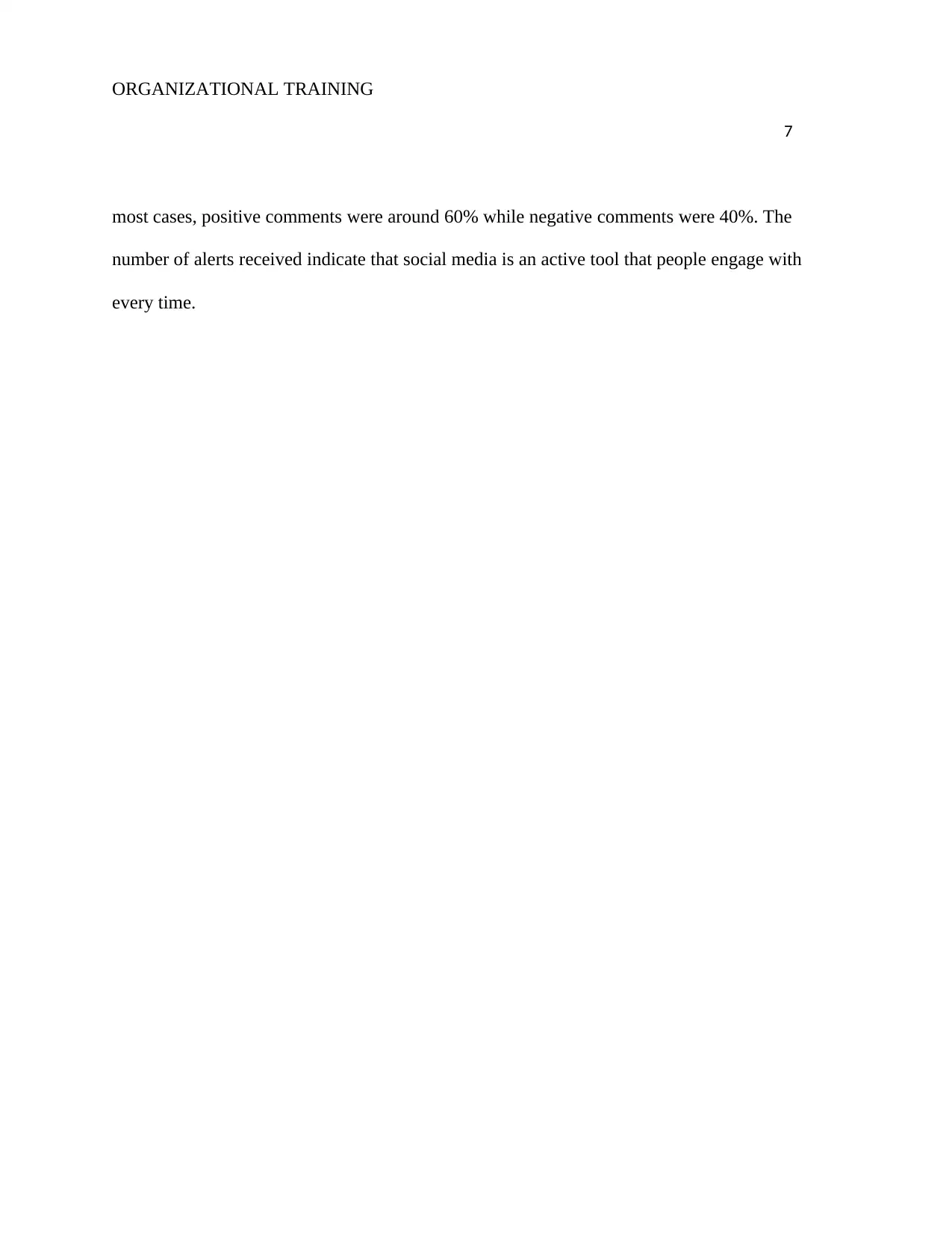
ORGANIZATIONAL TRAINING
7
most cases, positive comments were around 60% while negative comments were 40%. The
number of alerts received indicate that social media is an active tool that people engage with
every time.
7
most cases, positive comments were around 60% while negative comments were 40%. The
number of alerts received indicate that social media is an active tool that people engage with
every time.
Paraphrase This Document
Need a fresh take? Get an instant paraphrase of this document with our AI Paraphraser
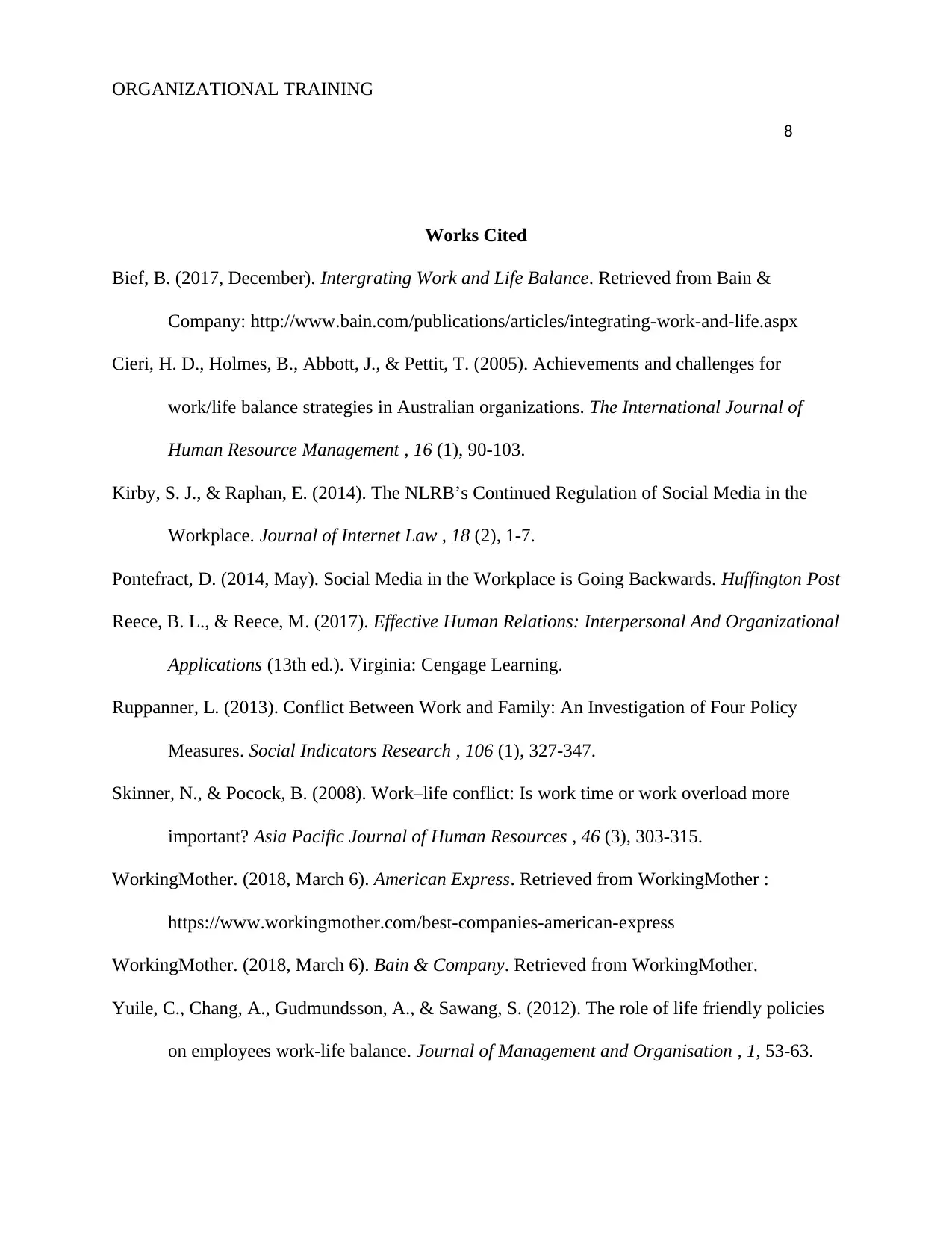
ORGANIZATIONAL TRAINING
8
Works Cited
Bief, B. (2017, December). Intergrating Work and Life Balance. Retrieved from Bain &
Company: http://www.bain.com/publications/articles/integrating-work-and-life.aspx
Cieri, H. D., Holmes, B., Abbott, J., & Pettit, T. (2005). Achievements and challenges for
work/life balance strategies in Australian organizations. The International Journal of
Human Resource Management , 16 (1), 90-103.
Kirby, S. J., & Raphan, E. (2014). The NLRB’s Continued Regulation of Social Media in the
Workplace. Journal of Internet Law , 18 (2), 1-7.
Pontefract, D. (2014, May). Social Media in the Workplace is Going Backwards. Huffington Post
Reece, B. L., & Reece, M. (2017). Effective Human Relations: Interpersonal And Organizational
Applications (13th ed.). Virginia: Cengage Learning.
Ruppanner, L. (2013). Conflict Between Work and Family: An Investigation of Four Policy
Measures. Social Indicators Research , 106 (1), 327-347.
Skinner, N., & Pocock, B. (2008). Work–life conflict: Is work time or work overload more
important? Asia Pacific Journal of Human Resources , 46 (3), 303-315.
WorkingMother. (2018, March 6). American Express. Retrieved from WorkingMother :
https://www.workingmother.com/best-companies-american-express
WorkingMother. (2018, March 6). Bain & Company. Retrieved from WorkingMother.
Yuile, C., Chang, A., Gudmundsson, A., & Sawang, S. (2012). The role of life friendly policies
on employees work-life balance. Journal of Management and Organisation , 1, 53-63.
8
Works Cited
Bief, B. (2017, December). Intergrating Work and Life Balance. Retrieved from Bain &
Company: http://www.bain.com/publications/articles/integrating-work-and-life.aspx
Cieri, H. D., Holmes, B., Abbott, J., & Pettit, T. (2005). Achievements and challenges for
work/life balance strategies in Australian organizations. The International Journal of
Human Resource Management , 16 (1), 90-103.
Kirby, S. J., & Raphan, E. (2014). The NLRB’s Continued Regulation of Social Media in the
Workplace. Journal of Internet Law , 18 (2), 1-7.
Pontefract, D. (2014, May). Social Media in the Workplace is Going Backwards. Huffington Post
Reece, B. L., & Reece, M. (2017). Effective Human Relations: Interpersonal And Organizational
Applications (13th ed.). Virginia: Cengage Learning.
Ruppanner, L. (2013). Conflict Between Work and Family: An Investigation of Four Policy
Measures. Social Indicators Research , 106 (1), 327-347.
Skinner, N., & Pocock, B. (2008). Work–life conflict: Is work time or work overload more
important? Asia Pacific Journal of Human Resources , 46 (3), 303-315.
WorkingMother. (2018, March 6). American Express. Retrieved from WorkingMother :
https://www.workingmother.com/best-companies-american-express
WorkingMother. (2018, March 6). Bain & Company. Retrieved from WorkingMother.
Yuile, C., Chang, A., Gudmundsson, A., & Sawang, S. (2012). The role of life friendly policies
on employees work-life balance. Journal of Management and Organisation , 1, 53-63.
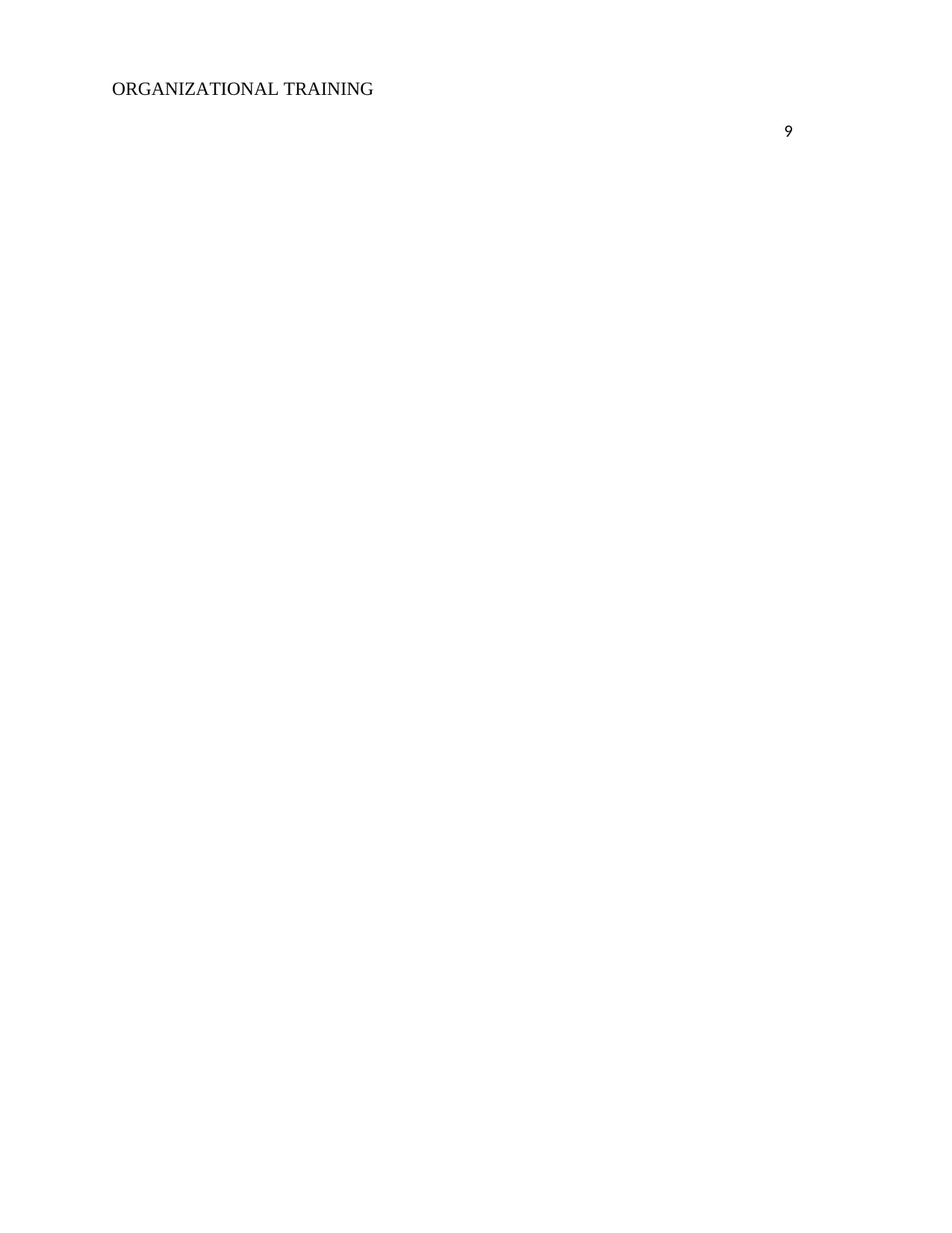
ORGANIZATIONAL TRAINING
9
9
⊘ This is a preview!⊘
Do you want full access?
Subscribe today to unlock all pages.

Trusted by 1+ million students worldwide
1 out of 9
Related Documents
Your All-in-One AI-Powered Toolkit for Academic Success.
+13062052269
info@desklib.com
Available 24*7 on WhatsApp / Email
![[object Object]](/_next/static/media/star-bottom.7253800d.svg)
Unlock your academic potential
Copyright © 2020–2025 A2Z Services. All Rights Reserved. Developed and managed by ZUCOL.



